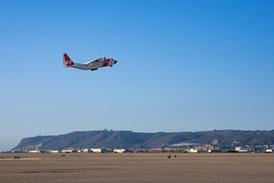Gulfstream Aerospace is taking its GV long-range business jet further upmarket, introducing an enhanced GV-SP with longer range at higher speeds, more usable cabin space and an advanced cockpit. ExecutiveJet has ordered 20 GV-SPs for its NetJets fractional ownership programme.
The surprise launch of the GV-SP was one of several market shifts unveiled at NBAA, as manufacturers reacted to the recent introductions of new aircraft.
The $45 million GV-SP will incorporate aerodynamic and engine upgrades that increase range at Mach 0.8 by 460km (250nm), to 12,490km, guaranteeing the aircraft can fly eight passengers from New York to Tokyo "in the most adverse conditions", says senior vice-president of programmes Press Henne.
More significantly, drag reductions will increase range by 550km at M0.85 to 11,100km, and by 740km at M0.87 to 9,250km. As GV operators often sacrifice range for speed, "we will pay more attention to higher speeds in developing the GV-SP", says Henne. Specific fuel consumption of the Rolls-Royce BR710 turbofans will be reduced 1.5%, while bleed management will contribute to a 46m (150ft) reduction infield length.

A new cockpit, called PlaneView and based on Honeywell's Primus Epic integrated avionics, will feature four large liquid-crystal displays and two cursor control devices. BAE Systems' head-up Visual Guidance System and Kollsman's infrared Enhanced Vision System will be standard.
Smaller avionics racks and other systems changes will allow Gulfstream to create a fourth seating area at the front of the cabin, with a seventh window added on the right side of the aircraft. Baggage capacity and completion allowance are to be increased.
The GV-SP is scheduled to fly in the fourth quarter of next year, leading to certification a year later and entry into service by the end of 2003. The SP will replace the current GV in production around the 200th aircraft, Henne says.
The changes make the GV more competitive against Bombardier's newer, faster Global Express and pave the way for the smaller GIV to be moved upmarket. Gulfstream has yet to launch the "next-generation" GIV, but has selected upgraded Rolls-Royce Tay engines and Primus Epic avionics for the aircraft.
Bombardier is expected to move ahead with plans for a new version of its Challenger large business jet after Cessna and Dassault revealed at NBAA their responses to the threat posed by the Canadian company's Continental super mid-size jet, as well as Raytheon's Hawker Horizon.
Cessna is to increase the gross weight and thrust of the M0.92 Citation X to improve take-off and climb performance, and to distance the $18.8 million aircraft from the Continental and Horizon, both priced around $15 million.
Dassault's new Falcon 2000EX will be priced at $24 million when it enters service in 2003, placing it head to head with Bombardier's Challenger 604. The twinjet features new Pratt & Whitney Canada PW308C engines and an advanced cockpit based on Honeywell's Primus Epic (Flight International , 10-16 October).
The French manufacturer hopes to penetrate the Challenger's sizeable market share, when its EASy cockpit becomes available in 2004.The first will be installed a year earlier on the larger Falcon 900EX trijet. Dassault has no plans to halt production of the basic 2000, its best-selling model.
Source: Flight International























